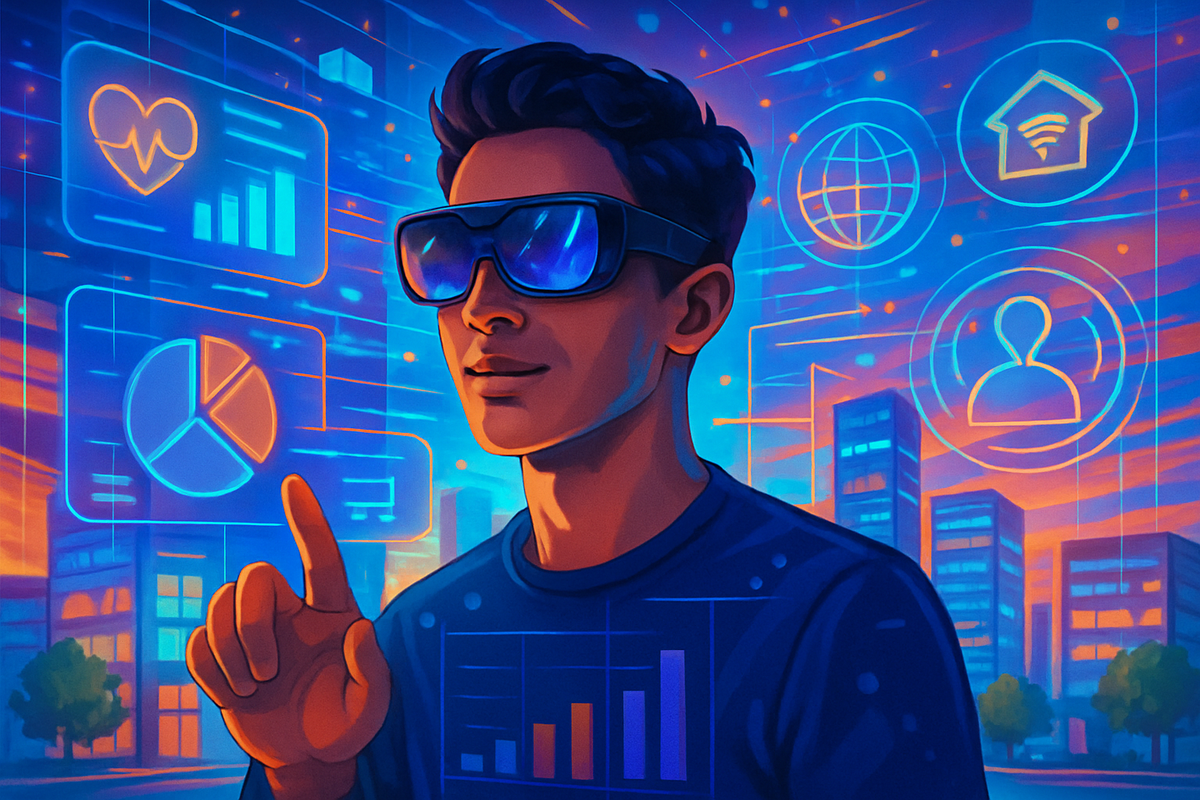AI Glasses, Digital Twins & Your Next Reality: How Spatial Computing Will Transform Daily Life (2025-2030)
Spatial computing is set to revolutionize your life, merging AI, AR, and digital twins to transform work, home, and entertainment. Discover how the top tech giants are investing billions into this seamless bridge from digital to reality.

Welcome to Your Next Reality: The Spatial Computing Revolution
Imagine this: You slip on a pair of sleek AI-powered glasses. Instantly, your calendar floats beside your morning coffee, your home’s digital twin suggests energy savings, and your favorite playlist follows you room to room. This isn’t science fiction. It’s spatial computing—and it’s about to turn your world inside out from 2025 through 2030.
"Spatial computing is the invisible bridge between your digital life and the physical world—making tech feel less like a tool and more like a sixth sense."
Let’s peel back the buzz and get real: What is spatial computing? Why are Apple, Meta, and Samsung pouring billions into it? Most importantly: how will it change your work, home, health, and play? Strap in—your next reality starts now.
Spatial Computing, Decoded: AI Glasses, Digital Twins & Mixed Reality
Spatial computing unites artificial intelligence, augmented reality (AR), virtual reality (VR), and real-time world mapping. At its core, it’s about layering digital information over physical spaces—so you can see, interact, and even feel data in the real world.
- AI Glasses: Lightweight, always-on wearables that overlay directions, messages, or even translation into your field of view—no phone required.
- Digital Twins: Virtual copies of your home, office, or body—used for everything from energy savings to remote health monitoring.
- Mixed Reality Overlays: Real-time data (think: weather, reviews, or friend’s avatars) floating in your space, precisely where you need it.
It’s not about escaping reality—it’s about making reality smarter.
Everyday Magic: How Spatial Computing Will Shape Your Life
1. Work & Collaboration: From Zoom Fatigue to Holographic Huddles
Say goodbye to flat video calls. With spatial computing, you’ll collaborate with lifelike avatars, gesture at shared 3D models, and walk through digital twins of your workspace. Imagine troubleshooting a factory machine from home—or brainstorming with colleagues as if they’re really in the room (awkward coffee breath not included).
- Remote workers: Mixed reality boardrooms with persistent digital whiteboards.
- Creators: Real-time 3D design, sculpting, or editing—no mouse needed.
2. Shopping & E-Commerce: Try Before You Buy (Literally)
Forget guessing if that sofa fits. AR glasses project it right into your living room. Browsing online? See clothing, gadgets, or even shoes on your own body or shelves. Impulse shopping meets spatial computing—dangerously convenient!
3. Health & Wellness: Digital Twins for Your Body and Mind
Wearable sensors and AI-powered overlays will guide workouts, monitor posture, and even alert you to subtle health changes. Doctors can consult via your digital twin, overlaying scans or treatment plans as you watch. Privacy alert: Choose carefully who gets access to your virtual self!
4. Entertainment & Social: Reality, Upgraded
Concerts in your living room. Multiplayer games that blend with your backyard. Or, if you’re feeling introverted, immersive storyworlds that transform your apartment into a fantasy castle. Spatial computing makes every day a choose-your-own-adventure.
5. Home & Smart Living: Automation Gets Personal
Your home’s digital twin predicts energy needs, security issues, or even suggests mood lighting. Walk into your kitchen and see recipe steps float by. Ask your AI glasses to start the coffee—no more shouting at your smart speaker.
The Devices & Apps to Watch: 2025’s Spatial Computing All-Stars
- Meta’s Ray-Ban Smart Glasses: Already selling millions, these blend style with voice AI and AR overlays. Expect new models with better displays (and maybe fewer accidental selfies).
- Apple Vision Pro & ARKit: Apple’s headset is the poster child for premium mixed reality. Rumor has it lighter, more affordable glasses are coming soon.
- Samsung & Google XR: Collaboration is heating up, with Samsung’s Project Moohan and Google’s XR pushing toward mainstream, affordable smart eyewear.
- Home Automation Apps: Digital twin management platforms are integrating with smart home devices for seamless control—think: one dashboard for everything.
- Spatial Productivity Suites: Watch for AR-native versions of Microsoft Teams, Slack, and design tools—already in beta with select partners.
Pro tip: Don’t buy on hype alone. Look for devices with strong developer support, open ecosystems, and clear privacy controls. And always check for deals—early adopters can snag significant savings through affiliate retailers.
The New Dilemmas: Privacy, Data Ownership & Digital Fatigue
With great power comes... a lot of awkward questions. Who owns the data your AI glasses see? Will your digital twin be used for good—or to sell you yet another subscription box?
- Privacy: Choose devices with transparent data practices. Insist on local processing for sensitive info—not everything needs a cloud.
- Digital Boundaries: Learn to pause the overlays. Set “focus zones” where you’re not bombarded by notifications, even if your fridge wants to talk about milk.
- Security: Digital twins are powerful, but they’re also targets. Use strong authentication and watch for updates.
"The most important skill in the age of spatial computing? Knowing when to unplug."
Forecast: 2025-2030—What’s Next for Your Reality?
- By 2026: AI glasses become as common as smartwatches in major cities. Expect mass-market models under $500.
- 2027: Digital twins for homes and offices become standard in real estate and energy management.
- 2028-2030: Spatial computing weaves into education, travel, and even dating. Expect AR navigation on vacation and virtual-first workplaces for creative industries.
Bottom line: The next five years will see spatial computing move from cool-party-trick to daily essential. The only real question is: How will you use your new powers?
Ready to Step Into Your Next Reality?
If you found this guide useful, you’re exactly the kind of curious, tech-forward thinker we love at Funaix. Want more hands-on tips, expert picks, and early-bird savings on the best spatial computing gadgets and apps?
Subscribe for free to become a Funaix Insider! Only subscribers can write and read blog comments. It’s free—for now. Join here and shape the conversation about your next reality.
Article published on August 19, 2025. Curated for the future-focused reader by the Funaix editorial team.




